Ararat, the Cradle of Civilization?
The Sumerians, an ancient peoples and one of the first civilizations in the world called Ararat, Arrata. In their great epic poems of Gilgamesh and Arrata, they tell of the land of their ancestors, the Arratans in the Highlands of Armenia. The Sumerians also in the epic poems describe the Great Flood and the rebirth of life after the terrible deluge that fell from the Highlands of Armenia unto the lands of Mesopotamia and the Fertile Crescent. The Sumerians had a very close connection with the ancestral Land of Ararat and considered it as their ancestral homeland (many historians and archaeologists are convinced that the Sumerians initially lived in Northern Mesopotamia and Armenian Highland).The Greeks believed that the people who first worked with bronze and iron came from the same area, they called them Khaldi.
"The great majority of the cultivated plants of the world trace their origin to Asia. Out of 640 important cultivated plants, about 500 originated in Southern Asia. In Asia alone we have established five of the principle regions of cultivated plants.... The fifth region of origin in Asia is the Southwestern Asiatic centre and includes Asia Minor, Trans-Caucasia, Iran and Western Turkmenistan. This region is remarkable, first of all, for its richness in numbers of species of wheat resistant to different diseases...There is no doubt that Armenia is the chief home of cultivated wheat. Asia Minor and Trans-Caucasia gave origin to rye which is represented here by a great number of varieties and species....
Our studies show definitely that Asia is not only the home of the majority of modern cultivated plants, but also of our chief domesticated animals such as the cow, the yak, the buffalo, sheep, goat, horse, and pig...The chief home of the cow and other cattle, the Oriental type of horse, the goat and the sheep is specifically Iran....
As the result of a brilliant work of Dr. Sinskaya, the discovery was recently made that the home of alfalfa, the world's most important forage crop, is located in Trans-Caucasia and Iran....
From all these definitely established facts the importance of Asia as the primary home of the greatest majority of cultivated plants and domesticated animals is quite clear."
The above quotes from the book by Vavilov, N. , "Asia: Source of Species" in Asia, February 1937, p. 113, indicate a long held belief by many that cradle of civilization was in the hills of Armenia. Also the location of the Garden of Eden and the location of the flood and the landing place of the Ark of Noah!
More recent studies conducted by Melinda A Zeder and Brian Hesse (Science 287 (2000) 2254-57) place the initial domestication of goats to the Zagros Mountains at about 10,000 years ago. And Manfred Heun's (Science 278 (1997) 1312-14) studies indicate that large scale wheat cultivation began from 8,000 to 9,000 years ago near the Karacadag Mountains. Both areas are very near where the Tigris and Euphrates Rivers come close together. They later modified the dates and moved them back about 1,000 years.
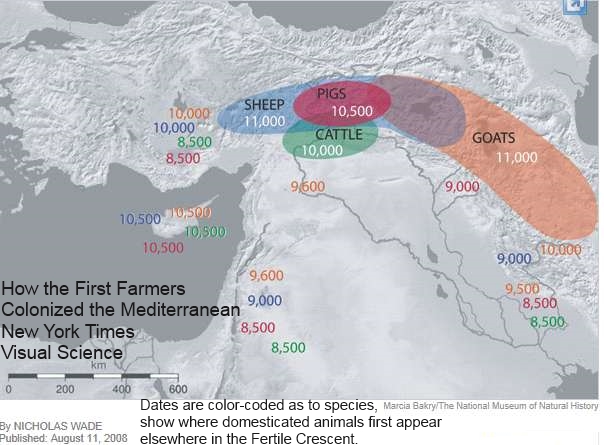
"The cradle of agriculture generally has been placed in the Jordan Valley of the southern Levant (today's Israel and Jordan). But work by Simcha Lev-Yadun of Israel's Agricultural Research Organization and colleagues suggest the first farms may have been farther north, between the Tigris and Euphrates rivers in what is today northeastern Turkey and northern Syria.
Wild progenitors of the main Neolithic founder crops (einkorn wheat, emmer wheat, barley, lentil, pea, chickpea, bitter vetch, and flax) are found together only in this small core area of the Fertile Crescent.
Lev-Yadun reports that wild chickpea especially is extremely rare, yet it was a staple crop of Neolithic life 10,000 years ago. Agriculture, therefore, probably began in an area where chickpea is native. Archaeological evidence shows that the earliest known farming settlements of the Fertile Crescent were in this core area. Also, the limited genetic variability of these crops implies that they were domesticated only once — rather than by several different cultures at roughly the same time. Evidence of domesticated crops in the core area dates to about 10,000 years ago, while the earliest signs of farming elsewhere are about 9,300 years ago.
Neolithic sites discovered in the core area indicate that a society with plenty of food thrived there. In sites such as Cayonu, Novali Cori, and Gobekli Tepe, impressive architecture, images, and artifacts have been found. Settlement sites are also larger in this area than many others of the same time in other parts of the Fertile Crescent. ..." (From "The Cradle of Agriculture? New Evidence Moves the World's First Farmers into Turkey" by Reagan Duplisea, http://www.discoveringarchaeology.com/ articles/ 060100-turkeyfarm.shtml)The emphasized areas of the above quote are indicators that this part of the Fertile Crescent was settled and developed first, consistent with the Genesis record.
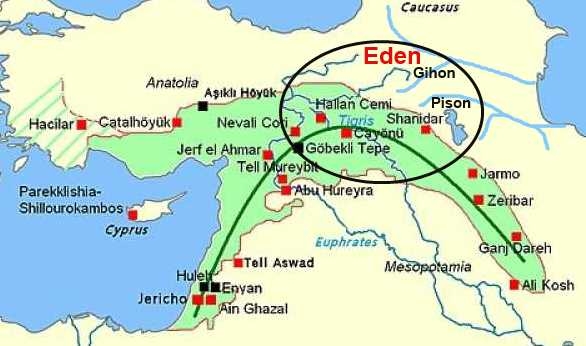
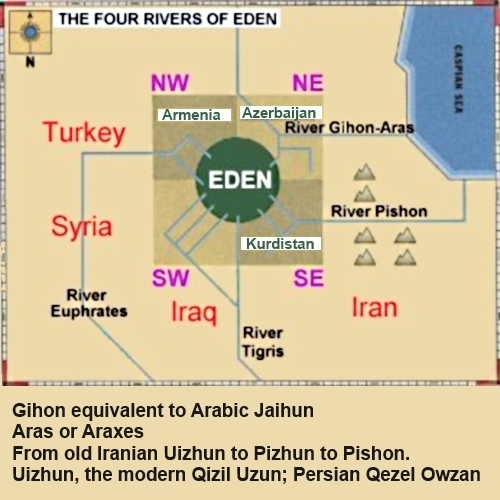
In the area a number of rivers have their source, including the Tigris and Euphrates. One of the four rivers named is said to flow about the land of Cush, but this is only one of several localities named Cush which are known to have existed. The best known of these later came to be identified with Ethiopia. But Ethiopia was not the only Cush. There was evidently one locality of this name in the Highland Zone. Pison has been identified with a certain river Phasis known to the ancient Greeks, which rose in the Caucasus and flowed into the Black Sea. The name however being a Hebrew (West Semitic) name derived from the old Iranian Uizhun, where the Iranian vowel 'U' had been converted into the Semitic labial consonant 'P'. Thus we have Uizhun to Pizhun to Pishon. The river Uizhun ( the modern Qizil Uzun; Persian Qezel Owzan ) is thus identified as the Biblical Pishon which flows down from the mountains of Kurdistan and empties into the southern basin of the Caspian Sea.
Easton says "it is probable that the Gihon is the ancient Araxes , which, under the modern name of the Arras, discharges itself into the Caspian Sea." And from the Keil & Delitzsch Commentary "The Gihon ... is the Araxes, which rises in the neighbor hood of the Euphrates, flows from west to east, joins the Cyrus, and falls with it into the Caspian Sea. The name corresponds to the Arabic Jaihun, ..." Even as late as the last century, Victorian atlases and encyclopedias were still naming the river as the Gaihun-Aras.

"The edin remains today one of the lushest regions of the Middle East:
thick soil, fruit orchards and vineyards, lazy meandering rivers."
(from http://www.nunki.net/PerDud/TheWorks/Express/Paradise.html)
The art of Urartu contained abundant depictions referring to the sacred tree, images of sacred trees guarded by seraphim and genii and sometimes attended by a king or kings.
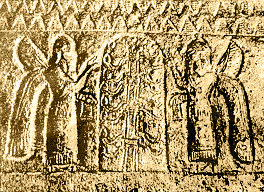
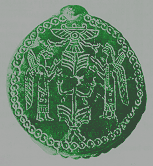
The Flood
We find considerable evidence today of progressive desiccation turning what was quite recently a well-watered area into a dry one. Rendle Short, referring to the findings of George Frederick Wright, had this to say: (Short, A. Rendle, The Bible and Modern Research, Marshall, Morgan and Scott, London undated, 2nd ea., p. 63.)
There is plenty of proof that the early home of the human race, Northern Persia, Armenia and the neighboring countries, has been under water at a comparatively recent date geologically speaking--certainly since the Ice Age.
At Trebizond, on the Black Sea, there is a raised beach of 750 feet up the mountain. The Caspian, the Sea of Aral and Lake Balkash have no outlet, but their waters are still comparatively fresh. Therefore, they must be of recent origin.
The significance of Rendle Short's last remark is apparent when it is remembered that the Dead Sea is anything but fresh, because it, too, has no outlet. The water accumulates the salts carried into it by various means, and the evaporation of the water serves only to concentrate these salts. That the Caspian Sea should still be fresh could be taken to mean that it has not been there any very great length of time, or that it has been flushed out, or that it has been added to very considerably.
Vere Gordon Childe remarks upon this same circumstance, although he attributes it solely to a much heavier rainfall at one time. (Childe, V. G., Fresh Light On the Most Ancient East, Kegan Paul, London, 1935, p. 24.)
On the Iranian Plateau the precipitation (which he predicates), though insufficient to feed extensive glaciers, filled the great hollows that are now salt deserts with shallow inland seas whose presence tempered the severity of the climate...
In Persia and Baluchistan the high strand lines encircling the old lakes bear witness to the flooding of these inland seas, and into them flowed many streams that are now lost in the desert.
In the same vein another authority, J. C. Curry, made the following observation: (Curry, J. C., "Climate and Migration" in Antiquity, September 1928, p. 295.)
There are several strands at varying heights along the southern shores of the Caspian, among the most clearly marked of which are those 600, 250, and 150 feet above the present level. Their weak development shows that, as a rule, the Sea did not stand at any one level for a long time. The state of their preservation shows that they are of very recent origin.
As a reference, it is estimated that present day sea levels are 400 feet above their ice age lows, and if all the polar ice caps were to melt, the sea levels would rise only an additional 275 feet. Then it seems that ice melting would not account for the water levels evident in the area.
The Resting Place for the Ark
There have been many ancient and modern reports of sightings of the ark. Most center around two sites, the modern Mt. Ararat (Agri Daugh, "mountain of pain") in the northern portion, and Mt Cudi ( Judi Dagh "highest" )in the southern portion. Many books, articles and videos have been prepared on the search for the ark in recent times. In ancient times sightings were reported by Berossus, the Samaritan Pentateuch, Targums, Josephus, Nicholas of Damascus, Hippolytus, Eusebius, the Pershita, Fautus of Byzantium, Epiphanius, Isidore of Seville, Eutychius, Al Masudi, Ibn Haukal, Zarariys ben Muhammad al Kazwine, and Benjamin of Tudela, covering from approximately 400 BC to the 13th century.
![[IMAGE]](cudi.jpg)
|
A rather interesting tradition is that the Christian sect called the
Nestorians had a monastery called "The Clositer of the Ark " reportedly built
of wood from the ark and it was destroyed by lighting in 766 AD. The center of
the Nestorian territory was just east of Mt. Cudi. (Photo at right of
the monestery taken by Gertrude Bell,
May 1909)
( See Appendix A below and also http://origins.swau.edu/papers/global/noah/default.html
for a more extensive discussions of the proposed ark landing sites.)
Conclusion: The evidence is rather compelling that the area that consists today of far eastern Turkey, northwestern Iran and Armenia was the cradle of civilization and where much of the saga of the early Genesis account took place.
Appendix A: from http://www.baseinstitute.org/research.html
The Search for the Real Mountains of Ararat
The biblical narrative and ancient historical records lead us elsewhere for the location of the mountains of Ararat. No where in the Bible does it mention the words Mount Ararat. The writer of Genesis says the Ark of Noah came to rest upon the mountains of Ararat (plural). This indicates that the Ark of Noah came to rest on a range of mountains and does not identify a specific mountain. The traditional Mount Ararat, known as "Agri Dagh," is a single mountain in a vast plain in eastern Turkey; it is not a region of mountains as the Bible specifies.
The Bible gives us a compass direction for the landing location of the Ark, and it is not in the direction of Turkey. The Bible says that the survivors of the flood journeyed "from the east" and, subsequently settled in "Shinar" (a region generally known as Babylon). Genesis 11:1 (NKJV)
- Now the whole earth had one language and one speech, and it came
to pass as they journeyed from the east that they found a plain in the
land of Shinar and they dwelt there.
If the survivors of the flood journeyed from the east, they would have come from the land in the direction of present-day, central Iran. Some Bibles have different translations for this verse: "journeyed in the east" or "eastward," which adds confusion to the actual direction from where the survivors of the flood traveled. Dr. Roy Knuteson, Ph.D. in New Testament Greek writes:
The Septuagint translation of the Hebrew Bible into Greek in 250 BC reads: from the east. This is significant since these Greek-speaking Hebrews knew the exact equivalent of the Hebrew into the Greek and chose a preposition (apo) that only means "from," not "in," or "towards," or "eastward." I would, therefore, choose the KJV translation for the correct rendering and head for the east of Babylon for the mountain with the Ark.
Another scriptural reference describing the location of Ararat is found in Jeremiah 51:27-28 (NKJV).
- Call the kingdoms together against her; Ararat, Minni, and
Ashkenaz. Appoint a general against her. Cause the horses to come up
like bristling locust. Prepare against her the nations with the Kings
and the Medes, its governors and all its rulers, all the land of his
dominion.
This verse tells us that the kingdoms of Ararat, Minni and Ashkenaz formed an alliance against Babylon. This would indicate that these regions were located in the dominion of the Medes. The NKJV study guide describes the location of the Medes as being from the Zagros Mountains in present-day, central Iran.
The Bible gives us a third reference to the location of Ararat. II Kings 19:36 says,
Now it came to pass, as he (Sennacherib) was worshiping in the temple of Nisroch his god, that his sons Adrammelech and Sharezer struck him down with the sword; and they escaped into the land of Ararat. Then Esarhaddon his son reigned in his place.
The ancient writings of Esarhaddon described his pursuit of the assassins into Ararat. He writes, "I reached the dyke of the Tigres as it if were a wide canal." This description alludes that he chased the assassins across the Tigres in the south where dykes were common in the Mesopotamian Valley. This would mean that the assassins probably went into what is known today as Iran and not north into Turkey.
The belief that the great boat (Ark) in which a family had escaped the waters of a worldwide flood could still be viewed at its original landing site began to be attested in the Near East in the late pre-Christian period. Reports of its survival continued through the Middle Ages and have intensified in the Christian West in the last century. It has become very popular to search Mount Ararat in Turkey even though this is an unlikely candidate for the Ark's resting place.
Around the beginning of the Christian era, readers of Genesis would probably understand the word "Ararat" in terms of the geography of their own day, rather than that of the Genesis narrator. That is, they might restrict the term to the small district on the Araxes, the Ararat of their time, rather than with the much larger ancient Kingdom of Urartu. Urartu could at times be considered the entire mountainous region north of Syro-Mesopotamia. The result would be that one tall mountain in this area, Agri Dagi (traditional Mount Ararat in Turkey), rising dramatically from the plain of the Araxes, would be considered the real Mount Ararat. By the time of the conversion of Armenia to Christianity (fourth century) and the introduction of an alphabet, so that the Bible could be translated into Armenian (fifth century), Armenia was a semi-independent kingdom whose religious and administrative centers were concentrated in the northern part of the country. Thus, when some persons read in the early translations that the Ark had come to rest in the "the mountains of Armenia," and when Armenians in particular read this in their own Bible, they might understand it in a much more restricted sense than the writer of Genesis intended. Attention would be focused too narrowly toward Agri Dagi in the north. It should be noted here that Armenian literature of the 5th through the 10th centuries knows nothing of any Ark story. It is not until the 13th century that the Ark legends began to appear in Armenia, and by the 14th century these stories became popular.
In the first century AD, Josephus discussing the royal family at Adiabene, remarks:
- ...{in} a district called Carra {Carron} in Adiabene-roughly
between the upper and lower Zab Rivers, tributaries of the Tigris…the
remains of the Ark in which report has it that Noah was saved from the
flood…to this day are shown to those who are curious to see them.
Josephus added that this land is rich with Amomom, an herb which grows there (known to grow in the mountains of central Iran). In the third century Hippolytus wrote:
- The relics of this Ark are ...shown to this day in the mountains
called Ararat, which are situated in the direction of the country of the
Adiabene {Iran}.
And possibly Julius Africanus, also writing in the third century, has this location in mind:
- ...and the Ark settled on the mountains of Ararat, which we know
to be in Parthia {Iran}.
Another tradition locates the Ark in Persia (modern Iran). It was said to have landed in the area of Ecbatana (Hamadhan). A map in Calmet's Dictionnaire Historique de la Bible (1722), shows the Ark atop this mountain, which it calls "Mont Ararat."
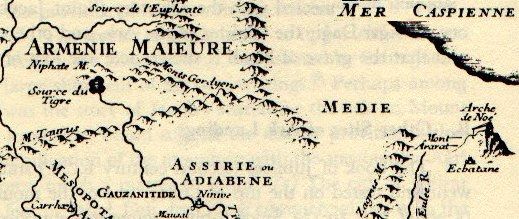

Ancient writings of the Assyrians tell of Assurnasirpal fighting a battle on Mount Nisir (Mount Ararat) which the Lullumi call Kinipa. The Lullumi and Zamua are from the same region. This region is in western Iran in the Zagros Mountains east of the lower Zab River.
- The Ark is said to have rested upon the mountains of Ararat, i.e.
in the mountainous region of Armenia, the plural showing that the
mountain peak known as Ararat (in Turkey) was not referred to. This peak
is of volcanic origin and lies outside the general region. It is only in
comparatively modern times that the present name (Mount Ararat) has been
given to it.
(International Standard Bible Encyclopedia)
- The Ark's landfall was probably in southern Uratu
{Iran}.
(NIV Study Bible)
Several ancient historians write about the great ship of Noah. Most do not place the Ark in the region of Agri Dagi in Turkey, but in areas far to the south. None of the ancient writers claim to have seen the Ark or any part of it, or to have visited a landing site-or even to have conversed directly with anyone who has. They only quote someone else, usually ending with the clichè, "It is said that the remains of the Ark are to be seen to this day." This they report, even if centuries have passed since the original source.
Have we solved the mystery of Noah's Ark on Ararat? Certainly not to the satisfaction of all Ark-searchers and other interested persons.
Recently, Bob Cornuke traveled to Iran to research the possibility of Ark legends in that country. He drove over 1,000 miles across rutted and dusty roads. He conducted countless interviews, asking the question "Is Noah's Ark on a mountain in Iran?" He received a negative response every time he posed the question. However, when he traveled to a province in western Iran, he received an overwhelming, "Yes," the Ark rests on a high mountain in that region. He was told that something is on top of this mountain, and he climbed as high as possible but was turned back by local tribesmen who said demons live on top of the mountain, and wild animals would harm him if he attempted to climb further. He was told that in order to see what is on top he would need more than a day to climb, and it would be difficult without ropes. He was alone in Iran on this research mission and wasn't prepared for intense climbing. Bob was further discouraged from his investigation by the local tribesmen; one even shooting his rifle over Bob's head twice as a gesture to go no further. He was intrigued that a living legend exists concerning the Ark. Bob reports, "Those who claim to have seen the old boat say that it has square edges and that it is the color of the soil."
Basically one just has to ask the question,
WHY would
the Lord set Noah and his friends down on a 17,000 foot high mountain?
Therefore, the Armenian traditions would seem to be favored as being the most realistic.
"NAKHICHEVAN, or NAKHJEVAN, a city of Russian Armenia, in the government of Erivan,
85 m. S.E. of the town of Erivan" (Yerevan) .
"Armenian tradition claims Noah as the founder of Nakhichevan (the Naxuana of Ptolemy),
and a mound of earth in the city is still visited by many pilgrims as his grave."
(from http://71.1911encyclopedia.org/ N/NA/ NAMAQUALAND.htm)
One of the proposed early names of the area is, 'Nuh chikhan'(the place where Noah landed).
(from http://www.fortunecity.com/ campus/ purdue/ 47/naxcivan.html)

Therefore, the authors are proposing that the most likely scenario was as follows:
a) Noah lived in the Aras (Araxes) river valley and there he built the famous Ark. (see Noah's Ark, How to build one )There are two traditional landing spots in the area, the Ilandagh (Snake mountain) chain (peak at 7825 ft. (2385 m))(from http://www.faik.00server.com/ index.html) and also Gapicig mountain as follows.
b) When the flood came, and when "Fifteen cubits upward did the waters prevail" the Ark with its passengers were floated on a severely flooded Aras river.
c) That when the flood receded the Ark finally settled somewhere around the rim of the Aras valley, not far from where it started its journey.
d) Then after the flood Noah and family settled in the area of Nakhichevan (Naxcivan).
Culture Minister Hamzayev: 'Noah's Ark is in Nakhichevan'
There are claims that the tomb of Noah and his sister, as well are also to be found in the regionTurkish Daily News
Ankara- The tomb of the prophet Noah and his sister may be resting in the region of Nakhichevan, the minister of culture for that location, Nizami Hamzayev, told the Anatolia news agency.
The Kohnekale (or old fortress) district, where the tombs are believed to be, is known among the people of the region as "Noah worshipper."
According to the minister, the famed Noah's Ark, sought for centuries in vain by scores of scientists, is also hidden in Nakhichevan.
Hamzayev said that during "Noah's Typhoon," which lasted a decade according to some history books, the Ark stayed above water for 10 months and came to rest on the Gapicig mountain, between the eastern province of Agri in Turkey and Nakhichevan, where marks believed to be made by the vessel can still be found.
But Hamzayev is not the only one that believes Noah's tomb is in Nakhichevan. The belief is widely held among the people in the region who often visit the tomb and pray at the site.
As well, acclaimed 16th century Arab writer Al-Sherefi and 19th century French traveler and writer Dubua de Monpere wrote that the tombs of Noah and his sister were in the Nakhichevan region.
Praising the cultural and historical richness of his lands, Hamzayev said they have undertaken to make gains for their state through tourism.
The minister also claimed that Noah's mother is buried in a mosque in Iran and that the people who settled in Nakhichevan and Iran are the people that left the Ark after the typhoon. (from http://www.turkishdailynews.com/ old_editions/ 02_20_97/ for.htm)



